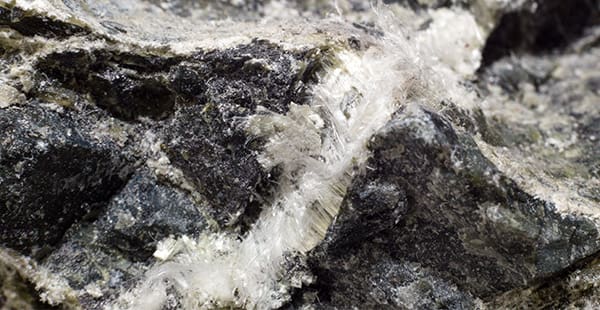What Is Asbestos and Where Is It Found?
Asbestos is the name for a group of six naturally occurring minerals made up of tiny fibers. Known for its durability and resistance to fire and corrosion, asbestos was widely used in insulation, flooring, roofing and other building materials. When disturbed or damaged, the fibrous mineral easily breaks apart, releasing harmful fibers into the air that can be inhaled. Over time, exposure can lead to serious health issues such as mesothelioma, lung cancer, and ovarian cancer.
Key Facts About Asbestos
- The last asbestos mine in the United States closed in 2002 due to health and liability concerns.
- Imports from Russia are the main source of asbestos in the U.S. today under certain restrictions.
- In 2024, the Environmental Protection Agency (EPA) finalized a rule banning the use of chrysotile asbestos.
- Over 60 countries have banned the use of all types of asbestos.
- Asbestos exposure is the primary cause of mesothelioma, it is also linked to other cancers like lung cancer and ovarian cancer.
History and Dangers of Asbestos Mining
To get the asbestos, companies had to mine it and then process it for use. Mining asbestos or minerals near asbestos, like talc and vermiculite, can create asbestos dust. The mining process can cause it to crumble and become airborne, which can be inhaled or ingested.
While asbestos is not currently mined in the United States, asbestos mining was prominent throughout the mid-to-late 1900s. Asbestos mining reached a peak in the late 1960s and early 1970s. According to The Agency for Toxic Substances and Disease Registry (ATSDR), over 299 million pounds of asbestos were produced in the late 1960s and early 1970s. But as more people learned about its dangerous health effects, asbestos mining decreased. Production dropped to 13.2 million by 1998 and the last U.S. asbestos mine closed in 2002.
Because asbestos is a naturally occurring mineral, deposits can be found in many places around the world. In the United States, the west and east coasts have the most asbestos. As of 2024, Russia, Kazakhstan and China lead global asbestos production and reserves.
Types of Asbestos
There are six types of asbestos that were used for commercial purposes. All asbestos is fibrous, meaning individual microscopic fibers make up the mineral. Each type of asbestos falls into either the serpentine or amphibole asbestos mineral family based on the shape of their fibers.
- Serpentine asbestos has long, curly, and flexible fibers. The only type in this category is chrysotile, also known as white asbestos.
- Amphibole asbestos has short, straight, and stiff fibers, shaped more like needles. This group includes actinolite, amosite, anthophyllite, crocidolite, and tremolite.
Characteristics of asbestos by type:
- Actinolite: Actinolite is part of the amphibole family and is often dark in color. Companies used it in cement, insulation, paints, sealants and drywall.
- Amosite: Also known as brown asbestos, this type is part of the amphibole family. Amosite is the second most common type of asbestos and makes up about 5% of asbestos used in the United States. Products that may have contained amosite asbestos include insulation, gaskets and tiles.
- Anthophyllite: This type ranges in color from yellow to brown and is part of the amphibole family. Anthophyllite asbestos was not used often in consumer products. But it may have been in some cement and insulation materials.
- Chrysotile: In the United States, chrysotile is the most common asbestos used. It makes up about 90% – 95% of asbestos used in buildings. Companies used it in a wide variety of insulation and fireproofing products. Chrysotile is the only serpentine asbestos and is also known as white asbestos.
- Crocidolite: This amphibole mineral is also known as blue asbestos. It is less heat resistant and used less often than other types. Products that may have contained crocidolite asbestos include cement, tiles and insulation materials.
- Tremolite: Tremolite is another type of asbestos from the amphibole family. It ranges in color from milky white to dark green. Products that may have contained tremolite asbestos include paint, sealants and plumbing materials.
Studies have shown that all types of asbestos, including chrysotile, the most commonly used type, can cause mesothelioma.
What Is the Difference Between Friable and Non-Friable Asbestos?
Friable asbestos is considered a higher health risk than non-friable. It can be easily crumbled, crushed or turned into powder by hand. Fibers easily release into the air and pose a greater health risk than non-friable asbestos.
- Examples of friable asbestos products include drywall, plaster, popcorn ceilings, insulation and spray-on insulation and fireproofing.
Non-friable asbestos is considered a lower health risk than friable. It is typically mixed with hard bonding materials like cement or vinyl, making it much more durable. These materials can’t be easily crumbled or crushed by hand. If undisturbed, non-friable materials are considered to be a lower health risk than friable materials. However, if non-friable asbestos are damaged, worn out or manipulated through activities like cutting, sanding or grinding, risk to health increases.
- Examples of non-friable asbestos products include vinyl floor tiles, roofing felt, cement roofing shingles, cement pipes and gaskets.
Any amount of exposure to asbestos can become hazardous if disturbed. Renovation projects, natural disasters or accidents can all increase the risk of exposure. Federal regulations typically don’t apply to non-friable asbestos unless it is damaged, becomes friable or is disturbed during demolition or renovation.
Resources for Mesothelioma Patients
What Is Asbestos Used For?
Asbestos companies used the mineral in thousands of products to make them stronger and resistant to heat and corrosion. Some of these products include insulation, cement, flooring, roofing shingles and fireproof materials.
Asbestos as an additive was most common in the mid-1900s. Due to asbestos regulations in the 1980s, manufacturers began using asbestos alternatives.
Asbestos Products
Thousands of products once used asbestos as an additive. Asbestos regulations prevent many new uses of the mineral. Still, some may legally contain low levels of asbestos. Some imported products, like car brakes, still use asbestos. Other products contain 1% or less asbestos. Manufacturers do not need to disclose when they add asbestos if it meets this threshold.
Different forms of asbestos were used in products for various purposes. For example, amosite asbestos was common in construction and fireproofing materials. Asbestos-containing products may also look the same as non-asbestos ones. Concrete with asbestos often appears identical to regular concrete. However, some materials are easier to tell apart. Asbestos insulation may look like cotton or pebbles, while fiberglass insulation typically resembles wool.
Common asbestos products include:
- Asbestos tiles
- Construction materials
- Insulation
- Popcorn ceiling products
- Talcum powder
- Transportation and automotive products
- Vinyl materials
- Zonolite insulation
Asbestos Occupations
Some occupations put workers at a higher risk of asbestos exposure. Often, these jobs involve:
- Manufacturing products with raw asbestos. For example, using asbestos to create asbestos cement.
- Working with materials containing the mineral. For example, repairing vehicles with asbestos-containing brake pads.
- Working at asbestos jobsites or areas containing the mineral. For example, teachers working in classrooms with aging asbestos ceiling tiles. Repairs or renovations may also disturb and release these asbestos fibers.
Asbestos particles are not visible to the naked eye and are odorless. As a result, many workers are unaware of their exposure.
Occupations at higher risk of asbestos exposure include:
Secondary Asbestos Exposure
People may risk secondary, or secondhand, asbestos exposure. Secondary exposure happens when a person comes in contact with asbestos fibers through another person. For example, an asbestos worker may not know they have asbestos fibers on their clothing. Anyone who encounters the worker, such as friends or family members, could then be exposed to the fibers.
“When I was a little girl, my dad worked construction. He would come home from work, his jacket covered in dust. His jacket would be white, crusty from the drywall dust that he would be sanding off the walls. Anything that I had to do outside, I liked wearing my dad’s coat. It was just, you know, unbeknownst to us that it was chock full of asbestos.”

Mesothelioma Survivor
Is Asbestos Still Used in the United States Today?
The United States does not have a full asbestos ban. But regulations restrict some uses of the mineral. While asbestos mining is no longer allowed, some asbestos imports continue today. In 2021, 320 metric tons of asbestos were used in the United States.
Older asbestos products and materials are still in use throughout the United States. Companies can also manufacture some products with small amounts of the mineral.
Two major areas of concern about asbestos in the United States include:
- Older asbestos-containing products disturbed from damage, wear-and-tear or other activities. For example, buildings and homes built before the 1980s may contain legacy asbestos materials. Natural disasters, renovations and demolitions may disturb asbestos products in these buildings.
- Small amounts of asbestos may be allowed in some consumer products. For example, paint, talc, soil and vermiculite may all contain trace amounts of asbestos. Consumer products like makeup may be affected.
The Environmental Protection Agency (EPA) is investigating the dangers of asbestos use. Many hope this will lead to a complete federal ban on the mineral.
What Are the Health Risks of Asbestos?
Asbestos exposure may lead people to develop diseases, including mesothelioma and other types of cancer. Exposure to asbestos is a known health risk for workers and the general public. It can happen through primary or secondary exposure. This may take place at work, at home or in other places. Long-term, heavy exposure to asbestos increases the risk of asbestos disease.
Asbestos exposure occurs when someone inhales or ingests asbestos fibers. Those fibers then may embed in some organ linings and tissues. Over time, this may lead to the development of asbestos-related diseases.
Asbestos Cancers
Asbestos exposure may lead to asbestos cancers. These cancers can include laryngeal cancer, lung cancer, mesothelioma and ovarian cancer. Some studies show a link to other cancers, including breast cancer and colon cancer.
Mesothelioma
Mesothelioma is a cancer of the thin lining surrounding some organs. Asbestos exposure is the only definitive cause of mesothelioma. It may affect the linings around the:
- Adomen’s organs (peritoneal mesothelioma)
- Heart (pericardial mesothelioma)
- Lungs (pleural mesothelioma)
- Testes (testicular mesothelioma)
Mesothelioma has a long latency period. A latency period is the time between exposure to asbestos and the start of symptoms. Generally, this period is between 10 and 50 years.
“Mesothelioma is the best documented type of cancer that is known to be caused by an environmental agent.”

Mesothelioma Specialist
Other Asbestos Diseases
Asbestos diseases include asbestosis, pleural thickening, pleural plaques and other conditions. Some of these can also be an indicator of asbestos cancer.
Prolonged exposure to asbestos fibers can cause these illnesses. But no amount of exposure to asbestos is safe, including short-term exposure.
Finding Alternatives to Asbestos
Companies can choose from many asbestos alternatives. These alternatives have similar properties to asbestos, but they pose lower health risks. Asbestos alternatives include foam, flour and other fibrous fillers. While safer than asbestos, these alternatives may still present some health problems. Before using an asbestos alternative, individuals can review the associated benefits and risks.
In some cases, these alternatives may replace an asbestos-contaminated material. One such material is Johnson & Johnson (J&J) talc-based baby powder. Some samples of the powder tested positive for asbestos.
Since the 1980s, J&J produced a cornstarch-based powder alongside the talc-based powder. The company has been increasing cornstarch powder usage in recent years. In 2020, J&J stopped selling talc-based powder in the United States and Canada. The company stated it would make the full, global switch to cornstarch-based powders in 2023.
The History of the Asbestos Industry
Evidence suggests some asbestos companies knew about the dangers asbestos posed. Some of those companies chose to hide that information from the public.
By the middle of the 20th century, asbestos use was reaching its height in the United States. At the same time, the evidence against its safety had been mounting for decades. By the 1960s, research showed a clear link between asbestos exposure and mesothelioma.
Notable events in the asbestos use timeline include:
- 1900: An autopsy performed in England became the first documented death from asbestosis, a lung disease caused by asbestos. The victim was a 33-year-old worker at an asbestos textile mill.
- 1929: Johns-Manville employees began to complain about health issues related to asbestos exposure. This was one of the first documented cases of employees bringing asbestos complaints to their employer.
- 1940s: Experiments sponsored by the asbestos industry found cancer in mice after asbestos exposure. The industry allegedly started working to hide the results.
- 1942: The U.S. Navy documented its awareness of asbestos as a source of health issues.
- 1943: States began enacting workers’ compensation benefits for asbestosis. By 1945, eight states had laws in place.
- 1982: Johns-Manville filed for Chapter 11 bankruptcy protection. The company was facing roughly 11,000 asbestos lawsuits.
- 2024: In March, the EPA finalized a ruling to ban chrysotile asbestos.
Internal records show some companies were aware of asbestos-related health risks. Despite this knowledge, these companies continued using or manufacturing toxic asbestos products. J&J is one company suspected of ignoring the health risks of asbestos.
Many believe high profits led companies to continue using asbestos, despite its health risks. Many asbestos disease victims have filed lawsuits against companies for their negligence.
Asbestos Regulations and Laws
The United States has not banned asbestos, but its use is limited under federal laws and regulations. They govern the usage, handling, removal and disposal of new and existing asbestos products. These standards were enacted to protect the public from the health hazards posed by asbestos.
The earliest asbestos regulations arose in the 1970s. Over the years, legal uses of asbestos have become increasingly limited, but some are still permitted. The EPA oversees many aspects of asbestos regulation. And the Occupational Safety and Health Administration (OSHA) regulates asbestos use and safety in the workplace.
The Chrysotile Ban
In March 2024, the EPA finalized a rule ending the use of chrysotile asbestos in the United States. It is the only form of asbestos still actively imported into this country. The new rule specifically addressed ongoing uses of this type of asbestos. Certain applications were given longer time periods to phase out asbestos products. But the final rule will effectively ban chrysotile asbestos by the end of 2036.
Other types of asbestos were not banned. And the rule did not address existing forms of asbestos like those found in older buildings.
How Do I Get Compensation for Asbestos Exposure?
People who develop an asbestos-related disease may have legal options available. Some may qualify for a mesothelioma lawsuit or asbestos claim. Taking legal action may help these victims get compensation from negligent asbestos companies. This compensation can help ease financial burdens like lost income and treatment costs.
Mesothelioma patients and their families can talk to experienced mesothelioma lawyers. Depending on details of their exposure and diagnosis, asbestos victims may have various options.
Common Questions About Asbestos
- Is asbestos naturally occurring?
Yes, asbestos is a naturally occurring mineral and is not artificial. It is a fibrous mineral that forms in rocks and soil above and below ground. Companies that use asbestos must mine and process it. The term asbestos refers to a group of minerals that are used for commercial purposes.
- Is all asbestos cancerous?
Evidence suggests that all asbestos can cause cancer. The EPA classifies all asbestos as cancer-causing. No amount of asbestos exposure is safe. But not everyone exposed to asbestos will develop an asbestos-related disease. Other risk factors may also play a role.
- How small are asbestos fibers?
Asbestos fibers are invisible to the human eye and can only be seen through a microscope. The thin fibers range from 0.1 to 10 micrometers long and may be straight or curled. Their small size makes it difficult to recognize asbestos exposure when it happens.
- Is asbestos still used today?
Asbestos is still used globally in many products today. Under current asbestos regulations, the United States can import some of these products. Legacy asbestos is also present in many older buildings and materials. In March 2024, the EPA finalized a chrysotile asbestos ban. But until there is a total ban, the potential for asbestos exposure continues.
- How do I identify asbestos in my home?
Identifying or handling asbestos in the home should always be left to professionals. Homeowners with houses built before 1980 should be particularly careful. Various construction materials the builders used may contain the mineral.
Current regulations consider some products lower risk if asbestos is properly contained. Health risks are greater with exposed or disturbed asbestos fibers. Asbestos in the home could become a health risk during repairs or renovations. A natural disaster or regular wear-and-tear may also disturb and release asbestos fibers.










